Genealogy Book Club Gems: Add These to Your Must-Read List
These three must-read titles from our Genealogy Book Club would be great stocking stuffers for yourself or someone you love. See my newest book recommendations for family history lovers by best-selling authors Christina Baker Kline (Orphan Train) and A.J. Jacobs (The Year of Living Biblically)–and another author I recently discovered and couldn’t stop reading.

3 Must-Read Books for Family History Lovers
1. A Piece of the World by Christina Baker Kline
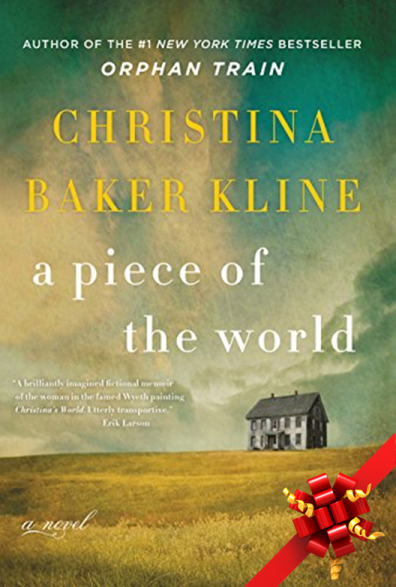 “You can never escape the bonds of family history, no matter how far you travel. And the skeleton of a house can carry in its bones the marrow of all that came before.” So says the Prologue to a new novel by best-selling novelist Christina Baker Kline, whose novel Orphan Train has been loved by millions around the world (and a lot of Genealogy Gems Book Club fans–we featured it in 2014).
“You can never escape the bonds of family history, no matter how far you travel. And the skeleton of a house can carry in its bones the marrow of all that came before.” So says the Prologue to a new novel by best-selling novelist Christina Baker Kline, whose novel Orphan Train has been loved by millions around the world (and a lot of Genealogy Gems Book Club fans–we featured it in 2014).
A Piece of the World is a unique and irresistible story about a woman whose physical disabilities and family’s demands keep her adventure-loving spirit firmly homebound. Granted, her home is a fascinating place: a 1700s-era home on the coast of Maine that has been passed down for several generations. But the noble legacy of the home instills a sense of obligation in those who live there now: do they stay on the family land at all costs, even the cost of their happiness and health? What happens when a family’s heritage becomes a burden, not a blessing?
Those who love American art will love that the main character, Christina, was inspired by the subject of the Andrew Wyeth painting, Christina’s World. (You can see an image of the painting here.) Christina was a real person who lived in this home. Andrew visited her and her brother and painted them many times. So the characters and setting are real, and the house is actually a National Historic Landmark now. Christina Baker Kline’s “fictional memoir” gives this historical Christina a powerful, honest, and insightful voice: the voice of a person who sees and tells it like it is–except the parts she just can’t see for herself.
2. It’s All Relative: Adventures Up and Down the World’s Family Tree by A.J. Jacobs
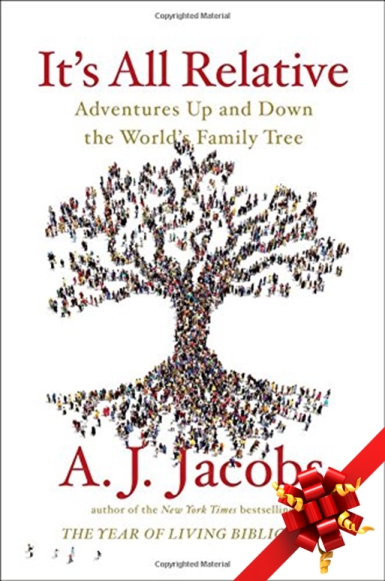 You could say A.J. Jacobs is famous for asking questions that seem both important and inane, and then pursuing the answers and writing about it. That’s what he did with his best-selling book The Year of Living Biblically, a chronicle of the time he tried to obey every rule in the Bible. Now he’s done it again in his new book, It’s All Relative: Adventures Up and Down the World’s Family Tree.
You could say A.J. Jacobs is famous for asking questions that seem both important and inane, and then pursuing the answers and writing about it. That’s what he did with his best-selling book The Year of Living Biblically, a chronicle of the time he tried to obey every rule in the Bible. Now he’s done it again in his new book, It’s All Relative: Adventures Up and Down the World’s Family Tree.
The questions A.J. set out to answer here were, “Who is really my family? And what would happen if I tried to host the world’s biggest family reunion?” He’s been working on this topic for a while. Remember the Global Family Reunion in 2015? That was his brainchild. He also spoke at RootsTech in 2016.
A.J.’s voice is witty with lots of digressions, pop culture references, and a definite urban beat (NYC, specifically). He meditates on what genealogical connections mean to him and the larger story the world’s family tree tells us. Like, we’re all related, and therefore shouldn’t we get along better? But with the quick disclaimer that he’s not inviting us all over for New Year’s brunch. He did that already at the Global Family Reunion–which he reports on in detail. (Did it succeed? Did it fail? I’ve been wondering myself since 2015). In the appendix, he recommends all kinds of genealogy how-to resources, including Genealogy Gems.
If you yourself are somewhat relaxed and perhaps even a little irreverent about your genealogy hobby, you’ll likely really enjoy this book. What about the more earnest family historians? It’s still worth a glimpse into how others see us. A.J. comes peeking into the world of genealogy ready to crack jokes. And he does plenty of that. But he also comes away with a great deal of respect for the stories and relationships that can–and should, he says–bring us closer together.
3. Shannon by Frank Delaney
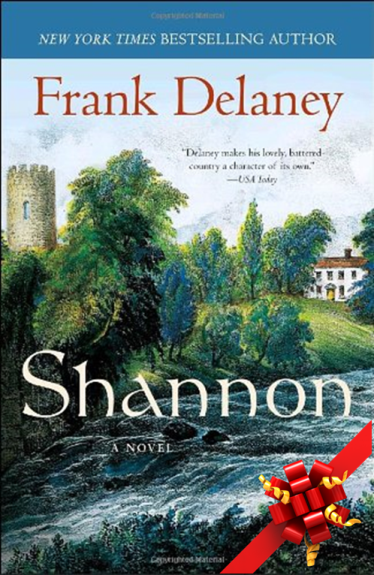 This isn’t a new book this year–it’s a classic I only recently discovered and can’t recommend more enthusiastically! I listened to the audiobook version, which the author narrates himself with great skill. Now I’m going to buy the print version so I can re-read, underline, and dog-ear all the passages that made me swoon. Oh. My. Goodness. Frank Delaney is a MASTER storyteller. He crafts every sentence, every image. You can practically see the story lines unfold, hear every action, smell it. I gasped, I cried, I laughed–all out loud in the car as I listened.
This isn’t a new book this year–it’s a classic I only recently discovered and can’t recommend more enthusiastically! I listened to the audiobook version, which the author narrates himself with great skill. Now I’m going to buy the print version so I can re-read, underline, and dog-ear all the passages that made me swoon. Oh. My. Goodness. Frank Delaney is a MASTER storyteller. He crafts every sentence, every image. You can practically see the story lines unfold, hear every action, smell it. I gasped, I cried, I laughed–all out loud in the car as I listened.
Shannon is a stunning tale: Father Shannon, an American Catholic priest of Irish descent, has serious “shell-shock” trauma after serving in the trenches of World War I. His archbishop sends him on a respite trip to Ireland to travel up the Shannon River looking for his family roots. He lands in the middle of an Irish Civil War—but also encounters person after person who helps him rediscover his faith in humanity and the restorative balm of daily life. Meanwhile, intrigue is afoot within his home archdiocese. A killer, who has his own traumatic backstory in Ireland, is dispatched to make sure Father Shannon never returns home. Their stories converge in a place of love, but also far too close to a place of pain. And that’s all I’m going to tell you about it. Read it or listen–and then clear a spot on your reading list for his epic novel, Ireland, which I read immediately after this one and also loved.
Genealogy Book Club: It’s All about YOU
 The Genealogy Gems Book Club is a service we provide the genealogy community because we love giving you more to talk and think about! We handpick our favorite mainstream fiction and nonfiction books that have great genealogy themes, such as someone searching out their family history, the complexities of family relationships, and the fascinating times and places our ancestors experienced.
The Genealogy Gems Book Club is a service we provide the genealogy community because we love giving you more to talk and think about! We handpick our favorite mainstream fiction and nonfiction books that have great genealogy themes, such as someone searching out their family history, the complexities of family relationships, and the fascinating times and places our ancestors experienced.
As a special bonus, we sometimes invite authors of our Book Club titles to join us on the Genealogy Gems Premium Podcast, available by subscription. It’s so fun to hear my favorite authors gush about the same kinds of topics I love! Hear from beloved and best-selling writers like Fannie Flagg, Annie Barrows, Helen Simonson, Lalita Tademy, and a favorite of genealogists around the world, Nathan Dylan Goodwin. Click here to see our full book list and where you can hear these interviews.
What Was it Like to Land at Ellis Island?
Chalked full of a rich history, Ellis Island was the leading port of arrival for the United States for sixty years. Read more about this historic place and the inspirational stories of immigrants past.
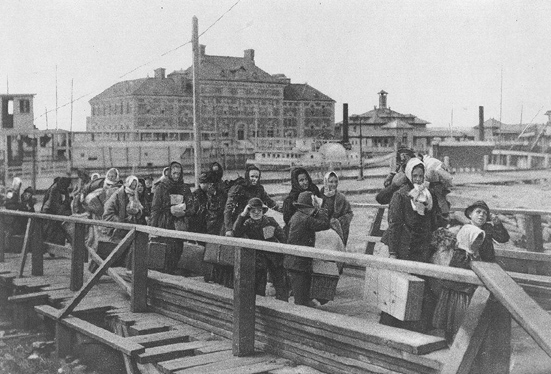
[Public domain], via Wikimedia Commons.
Ellis Island: What was it like?
Many of our ancestors first stepped ashore at Ellis Island when they came to America seeking a new life. I can only imagine their first thought might have been, “Get me off this boat!” But then, perhaps there was worry and trepidation. Would they be sent home because they were sick? Would they find work, a place to live, or food to eat?

Immigration Day at Half Day School, Lincolnshire, Illinois. 2010. Courtesy of the author.
The very first immigrant was processed in 1892. Her name was Annie Moore and she was a 15-year-old Irish girl. [1] Can you imagine?
One elementary school in Lincolnshire, Illinois recreates this event with their yearly “Immigration Day.” Immigration Day is for all 3rd and 4th students to participate in what it’s like to come to this country for the first time. They dress up, pack up a few belongings, receive little tickets and passports, and experience in a small way the history of many of their ancestors.
Arriving on land again must have been quite the relief to passengers. Especially those in steerage. Steerage or third class passengers traveled in crowded and often unsanitary conditions near the bottom of the ship. Upon arrival in New York City, ships would dock at the Hudson or East River piers. First and second class passengers would disembark, and pass easily through Customs. They were free to enter the United States. The steerage and third class passengers, however, were transported from the pier by ferry or barge to Ellis Island where everyone would undergo a medical and legal inspection. [2]
If the immigrant’s papers were in order and they were in reasonably good health, the Ellis Island inspection process would last approximately three to five hours. The inspections took place in the Registry Room (or Great Hall). Here, doctors would quickly look over every immigrant for obvious physical ailments.
If the immigrant was found with a minor ailment, broken bone, or found to be pregnant, they would be sent to the “Island Hospital, built to restore the health of people suffering minor injuries [and] broken bones.” [3]
An Ellis Island Myth
The ship’s manifest log, that had been filled out back at the port of embarkation, contained the immigrant’s name and his/her answers to twenty-nine questions. This document was used by the legal inspectors at Ellis Island to cross-examine the immigrant during the legal (or primary) inspection. [4]
There are some genealogical myths regarding Ellis Island. Many believe that their ancestors surnames were changed when they arrived. Some even believe the name change was due to the lack of native speakers of different languages and an overall lack of communication. This is not the case.
Vincent J. Cannato’s book American Passage: The History of Ellis Island explains why this did not happen:
Nearly all […] name change stories are false. Names were not changed at Ellis Island. The proof is found when one considers that inspectors never wrote down the names of incoming immigrants. The only list of names came from the manifests of steamships, filled out by ship officials in Europe. In the era before visas, there was no official record of entering immigrants except those manifests. When immigrants reached the end of the line in the Great Hall, they stood before an immigration clerk with the huge manifest opened in front of him. The clerk then proceeded, usually through interpreters, to ask questions based on those found in the manifests. Their goal was to make sure that the answers matched. (p.402)
A First-hand Look at Ellis Island
The official, award-winning documentary shown today at Ellis Island (more about that here) is available to watch online below. It is a wonderful way to get a first-hand look at what it felt like to land at Ellis Island and the a land of liberty.
 The Genealogy Gems Podcast (get our app) helps you make the most of your family history research time by providing quick and easy-to-use research techniques. Producer and host Lisa Louise Cooke brings you the best websites, best practices, and best resources available! Listen to all of Lisa’s podcast episodes on iTunes for free!
The Genealogy Gems Podcast (get our app) helps you make the most of your family history research time by providing quick and easy-to-use research techniques. Producer and host Lisa Louise Cooke brings you the best websites, best practices, and best resources available! Listen to all of Lisa’s podcast episodes on iTunes for free!3 Shocking Discoveries I’ve Made While Searching Cemeteries
There has always been something mysterious about cemeteries. Perhaps the knowledge that those interred took secrets to their grave has resulted in the enigmatic haze that seems to linger over these peaceful resting sites. But it’s not just the dead that hold secrets. Cemeteries themselves are often home to puzzling (and sometimes spooky) features.
Joy Neighbors, author of the book The Family Tree Cemetery Field Guide shares three of her most shocking finds while scouring cemeteries for genealogical clues.
Tombstone Tourist
We think of cemeteries as quiet tranquil places. As a “Tombstone Tourist,” I’ve spent years in cemeteries searching for genealogy clues, exquisite artwork, stunning vistas, and that perfect photograph. A trip to the graveyard is never boring. I’ve come back with tales of beauty, delight, and terror. Here are just three shocking discoveries I’ve made while searching in cemeteries.
1. Abandoned Crypts
There’s a cemetery in Kentucky that holds a baffling find; three 19th century mausoleums that have disappeared right in the middle of the grounds.
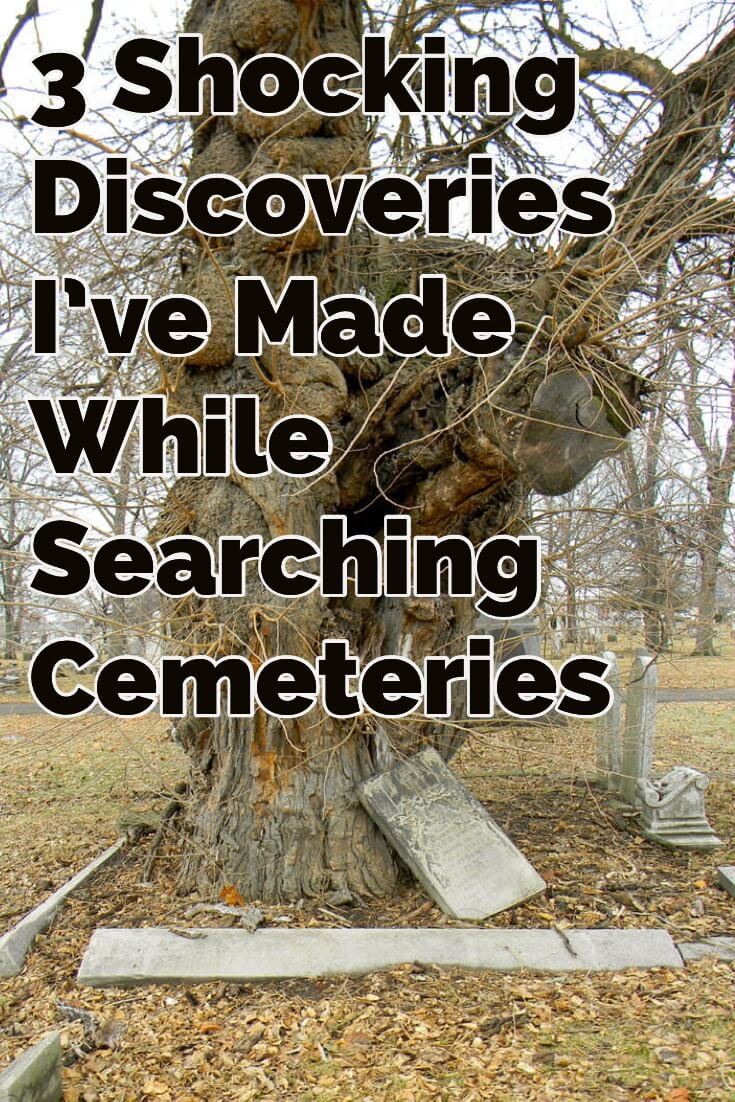
On a humid July day, I stepped inside a grove of trees to escape the searing heat. Inside that cool dimness stood three stately mausoleums, each with a façade protruding from a hill now enveloped in trees, vines, and shrubs. This thicket had been growing untamed for years.
The mausoleums stood side-by-side. The first was a small brick crypt with a surname above the entry along with a date “1895.” But the tomb had been bricked up for so long, trees grew on top obscuring its existence.
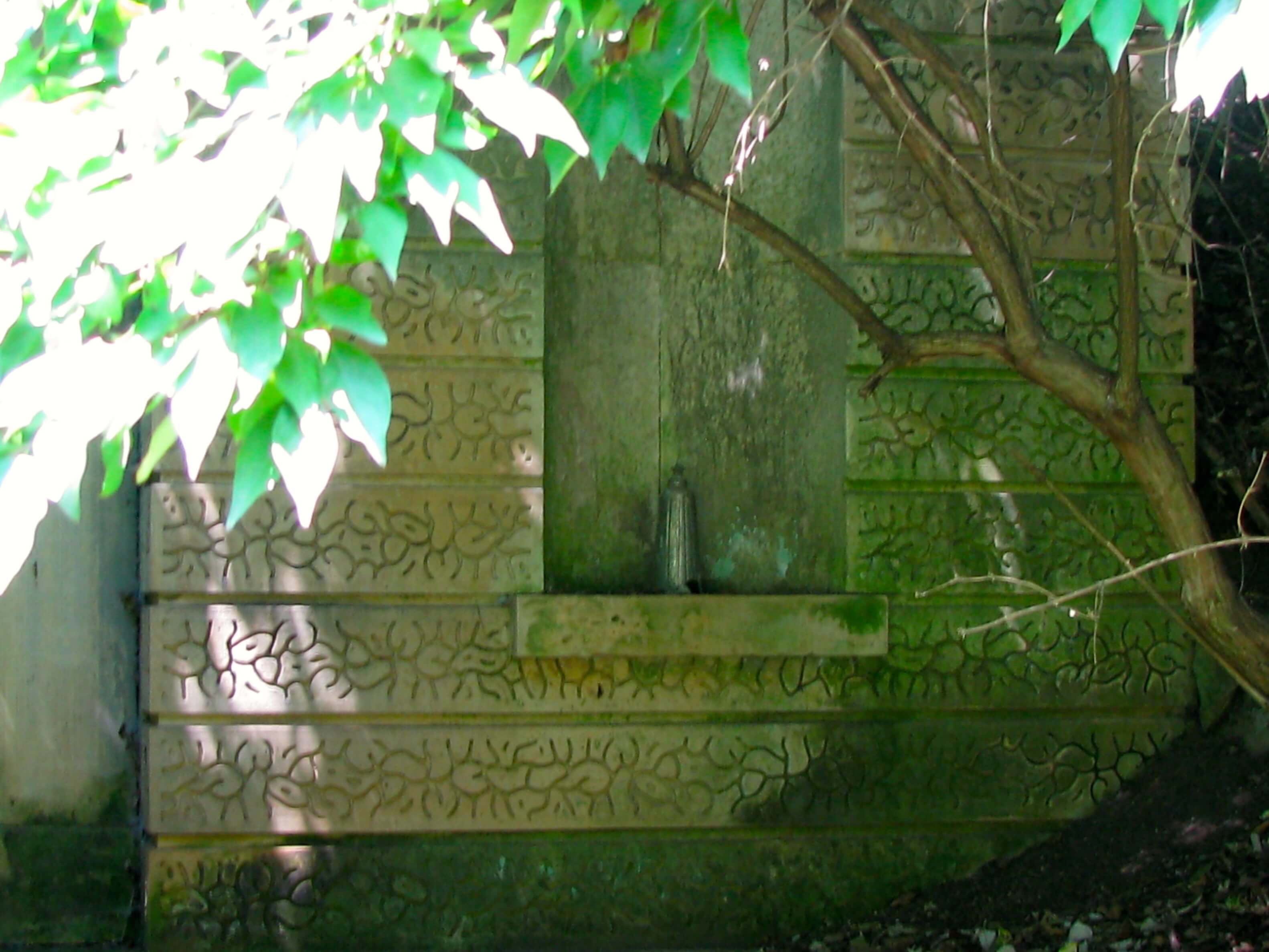
The middle mausoleum was built from pressed concrete with niches and arches along the walls. Again, the doorway and windows were bricked shut against the onslaught of trees and ropy vines that brushed and clung to its surface.
The third mausoleum was constructed of plainer concrete set off in a corner. No names or dates were visible but trees blocked any approach. It was visible only through a tangle of vines and foliage.
Who had these monuments been for?
Why had they been abandoned?
Had the bodies been moved when family members relocated?
Or were they simply forgotten?
Perhaps no one left payment for special care in perpetuity.
Apparently, what has been lost and forgotten shall remain so.
2. The Grave in the Middle of the Road
Having grown up in Indiana, I can assure you that Hoosiers are a practical lot. But there’s one roadside attraction that will cause the most stoic of residents to stop and ponder the audacity and fortitude it took to keep a grave in the middle of the road for close to 200 years.
The story began in 1808 when Nancy Kerlin married William Barnett, the great, great, great grandson of Pocahontas and John Rolfe.
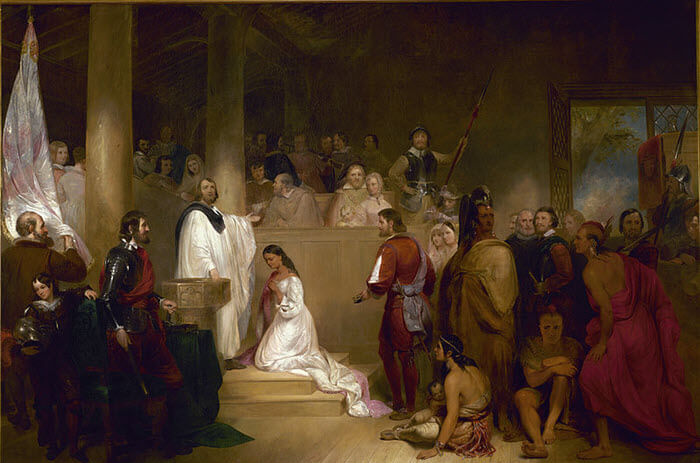
Baptism of Pocahontas by John G. Chapman, 1840. (Public Domain Image)
They settled near what would become Amity, Indiana to raise their family.
Nancy died on December 1, 1831 and was buried on top of a small hill overlooking Sugar Creek, one of her favorite spots. Soon others were also buried here and over the years a small county cemetery developed.
But then progress reared its head around the turn of the last century and Johnson County decided that a road needed to be built to connect Amity with other thoroughfares. This meant the grave had to be relocated.
Nancy’s grandson, Daniel G. Doty had a problem with that.
Doty went to the county and voiced his opposition. Nothing changed so he decided to take matters into his own hands. When county work crews arrived they found Doty sitting on his grandmother’s grave – with a loaded shotgun. Again, Doty told the county that his grandmother would stay where she was. If they insisted on trying to move her grave, they would have to deal with him. With that prospect, county workers agreed to let things “rest” where they were.
A concrete slab was placed over the grave in 1912 to protect it.
An historical marker was added in 1982, and Nancy became an anomaly.
But three years ago, after numerous reports of accidents, something had to be done.
In 2016, Nancy’s grave was temporarily moved to widen the road. It was the perfect time for University of Indianapolis archaeologists to see just what was buried there.
Amazingly, they discovered that residents have been driving past not only Nancy’s grave but also the remains of six others – a man, a woman and four children. Was this the Barnett family? No one’s said for sure but the state has now designated this small spot in the middle of the road a family cemetery.
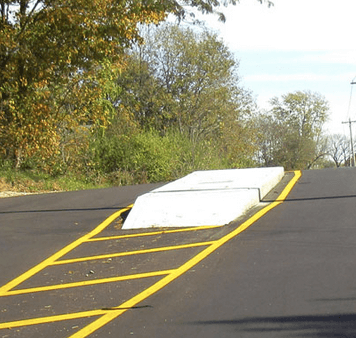
The Grave in the Middle of the Road
3. The Tree of the Dead
In Terre Haute, Indiana there stands the most massively disfigured cemetery tree I’ve ever encountered. Though its genus is no longer identifiable, it stretches at odd angles as if reaching out in despair.
It was a frigid January day when I encountered what I have since called “The Tree of the Dead.”
I’d been taking photos when my husband waved me over to see his find. Over the years I have seen hundreds of ominous cemetery trees, but none like this. This tree was surely waiting for the headless horseman to plunge through that opening with a rush of fetid air as he continued searching for his head.
Stepping closer, I attempted to take a photo, but the tree was having none of it. My camera shut down immediately. There are several explanations for this common cemetery occurrence; the batteries are too cold, connections are corroded, post seals are damaged, or spirits are sapping energy attempting to manifest. Yes, well … but after changing the batteries two more times, I had yet to get one picture.
My husband thrust his camera into my hands and I was able to get two photos before the batteries died. One shows the tree in all of its appalling façade with twisted limbs reaching akimbo to the sky. (Notice the limb with a dragon’s head at the end?)
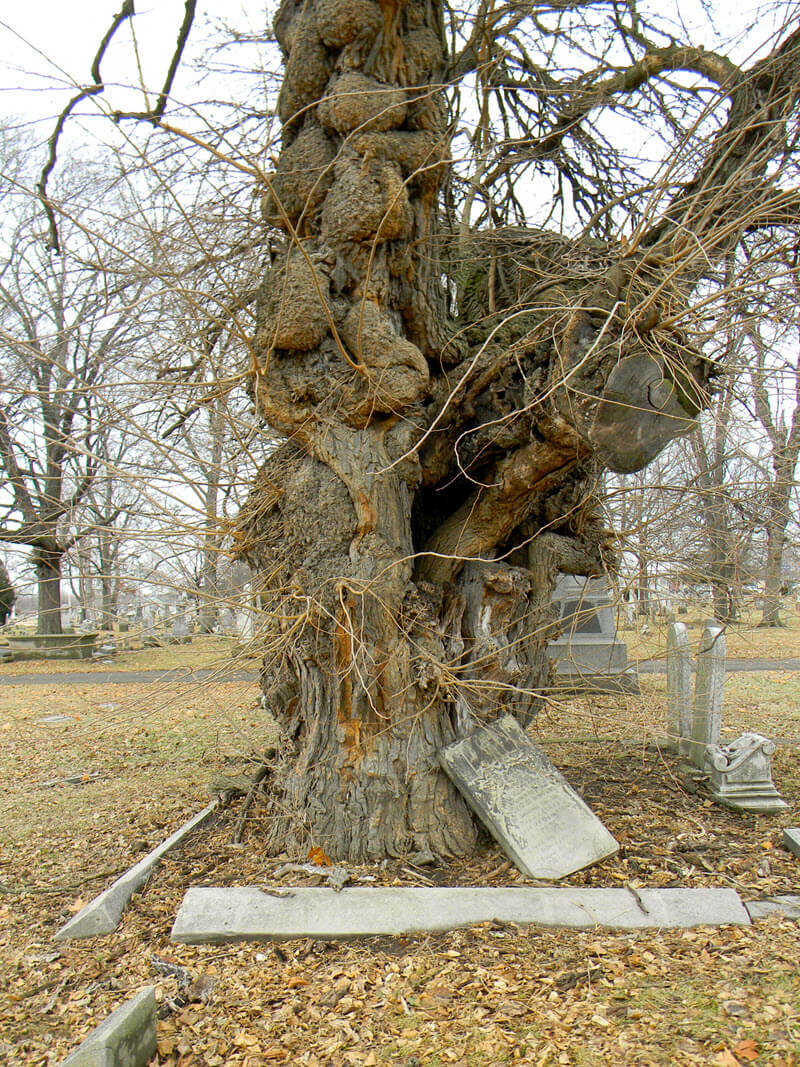 The second shot shows the opening in the middle of the tree: a bizarre heart shape. And the mishmash of tombstones scattered around the plot date to the late 1800s but names are indecipherable.
The second shot shows the opening in the middle of the tree: a bizarre heart shape. And the mishmash of tombstones scattered around the plot date to the late 1800s but names are indecipherable.
Who is buried here?
What happened to give the tree such an appearance?
Could it be caused by a decades-old drought?
Maybe arsenic used to embalm bodies back in the 19th century slowly leaching its way up into the tree?
Or could it be … something else?
A visual reminder of how perilously close fact and fiction are entwined in the graveyard.
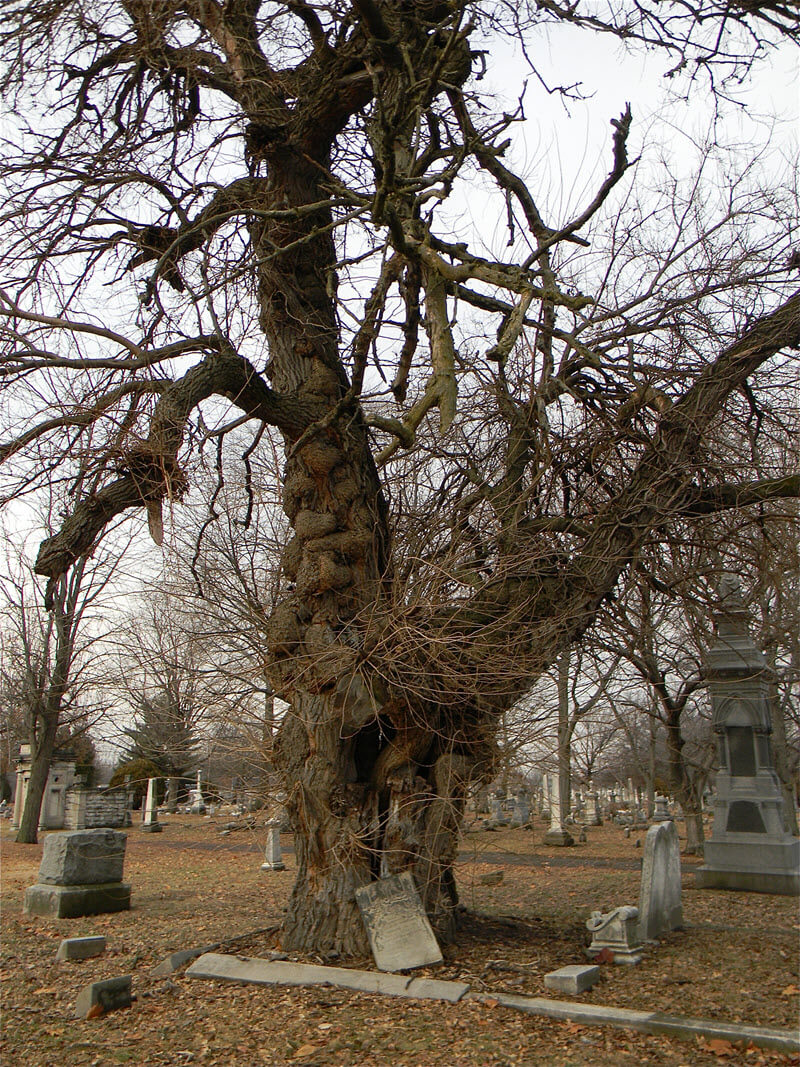
Cemetery Secrets
Cemeteries hold a vast amount of secrets, most of which we may never know. But the genealogist’s pursuit of answers means we’ll never stop exploring and asking the questions, and perhaps one day, those secrets taken to the grave may be revealed.
Cemeteries are crucial for any genealogist’s search, and The Family Tree Cemetery Field Guide by Joy Neighbors will show you how to search for and analyze your ancestors’ graves.
Discover tools for locating tombstones, tips for traipsing through cemeteries, an at-a-glance guide to frequently used gravestone icons, and practical strategies for on-the-ground research. And once you’ve returned home, learn how to incorporate gravestone information into your research, as well as how to upload grave locations to BillionGraves and record your findings in memorial pages on Find A Grave.
Click here to order your copy today!
Learn more about using Billion Graves:
(Click on player to unmute sound)
About the Author: Joy Neighbors is a national speaker, author, freelance writer, blogger, and avowed Tombstone Tourist. Her book, The Family Tree Cemetery Field Guide focuses on how to locate cemetery records, what to do when you get to the cemetery and how to understand the silent language of the stones. She also shares a few stunning family secrets along the way. Joy also writes the weekly cemetery culture blog, A Grave.

Disclosure: This article contains affiliate links and Genealogy Gems will be compensated if you make a purchase after clicking on these links (at no additional cost to you). Thank you for supporting Genealogy Gems!
4 Steps to Getting Started with Scrivener Software for Writing Family History
Scrivener software may be just what you need to write up your family history writing. Genealogist Lisa Alzo shares 4 steps for getting started.
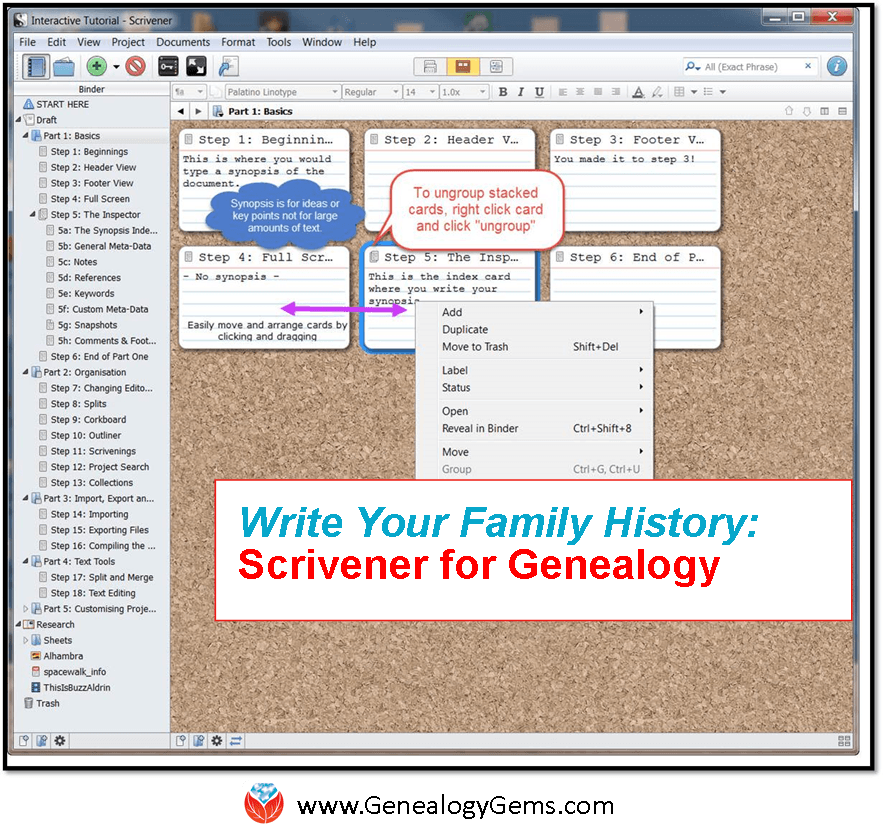
What is the Scrivener Software Program?
Scrivener is a software program that offers templates for screenplays, fiction, and non-fiction manuscripts. After composing a text, you can export it for final formatting to a standard word processor or desktop publishing software.
Scrivener is much more than a word processor. Thanks to the wide range of interfaces and features it offers, it is valued as a project management tool for writers.
It’s little wonder that Scrivener has grown in popularity with family historians who want to tell their ancestors’ stories. Genealogical information can become unwieldy at times. Scrivener makes it much easier to organize your material and write.
At RootsTech 2016, Lisa Alzo introduced Scrivener to fascinated audiences in the Genealogy Gems demo theater in the Exhibit Hall. I invited her to follow up by sharing Scrivener for genealogy with you, too. Here’s what she has to say.
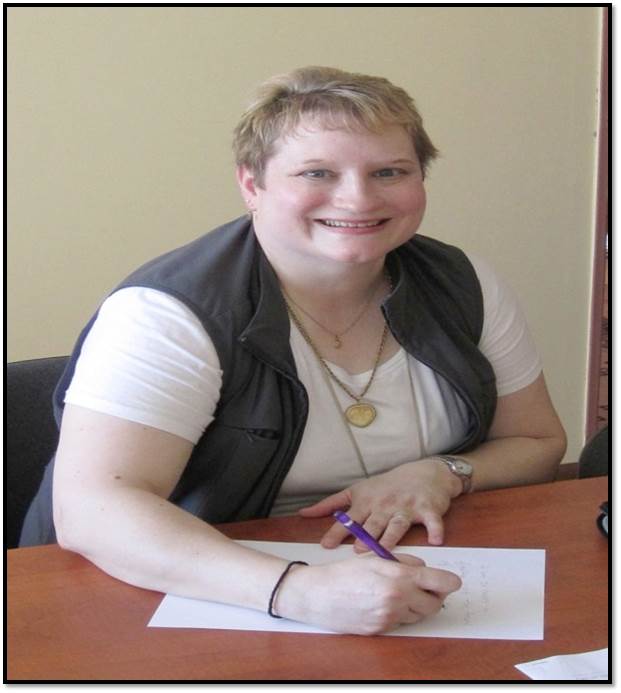
“It is no secret that I am an avid user of Scrivener, a multifaceted word processor and project management tool. I have been using this program for all of my personal and professional writing projects since 2011.
Here are four steps to get up and running with Scrivener so you can use it to organize and write your family history:
1. Download Scrivener
Scrivener is produced by Literature and Latte and is available for purchase for use on Mac ($45) and Windows ($40). (Pricing as of the writing of this article.) There is also a 30-day free trial available.
Double click the Scrivener “S” icon on your desktop to open the program.
Before you start your first project, take a few minutes to review the Scrivener manual for your and watch the helpful interactive tutorials.
2. Start your first project
Go to File and New Project.
The New Window allows you to choose from different project templates.
I highly recommend starting with the “Blank,” which is the most basic and creates a simple project layout you can build upon and customize later.
The “Save As” box appears for you to give your project a name (e.g. Alzo Family History) and tell Scrivener where you would like to save your project (e.g. a desktop folder, or you if you are a Dropbox user you can easily save your projects there so that you can easily access them from another computer or laptop). You will not be able to continue until you save your project.
TIP: Start small!
Begin with a smaller project like an ancestor profile or blog post rather than attempting to write a 200-page family history book your first time in.
3. Plot, plan, and outline away!
Whether you are a visual writer who likes to storyboard, or if you prefer text outlines, you can use Scrivener your way. When you start a new blank project, you will be see the “Binder” (located on the left-hand side), which is the source list showing all documents in the project.
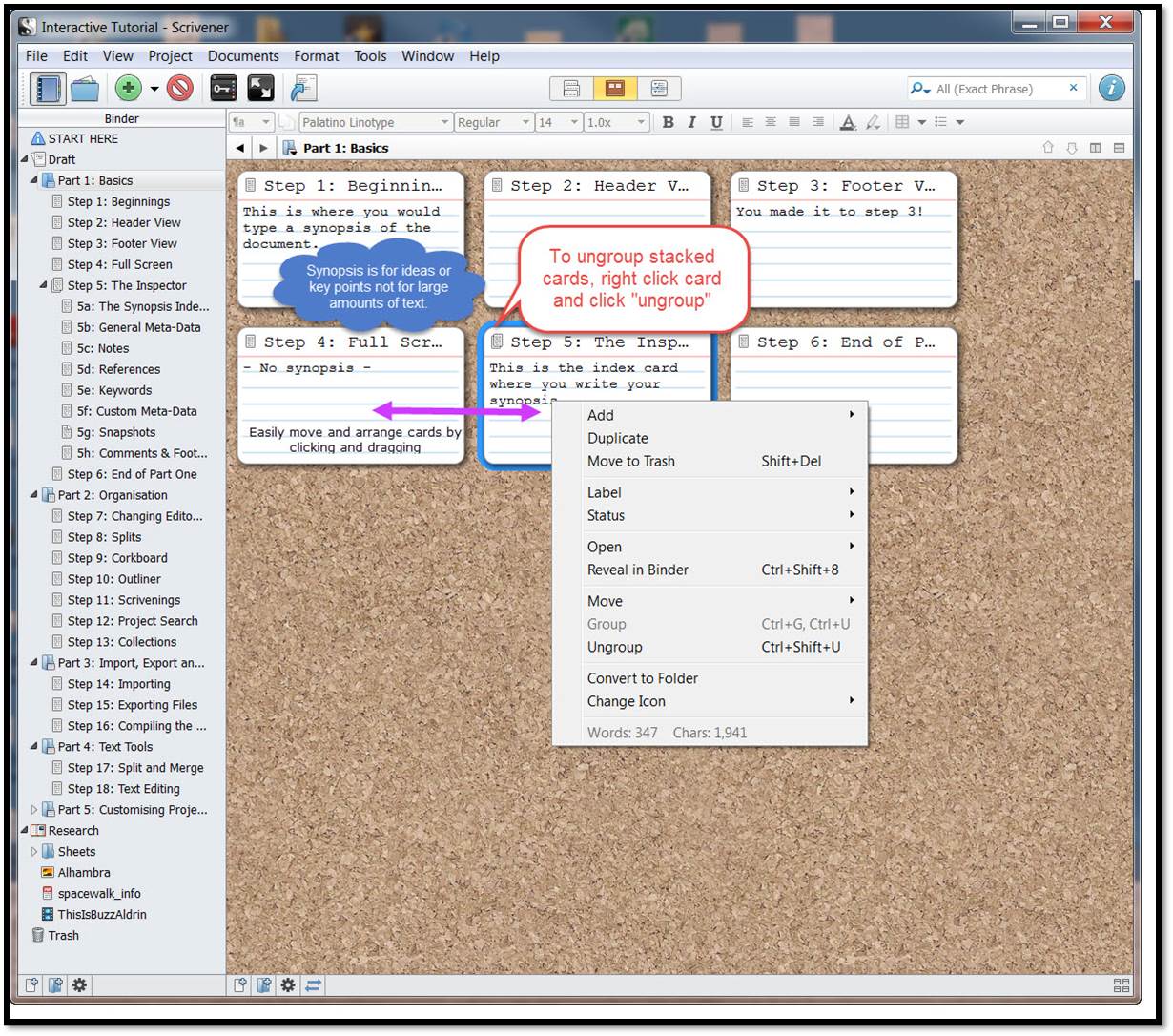 By default you’ll see three folders:
By default you’ll see three folders:
The “Draft” board (called “Manuscript” in other Scrivener templates) is the main space where you type your text (you can compile everything in that folder for printing or export as one long document later on).
The Research folder is where you can store notes, PDF files, images, etc. (not included in your final compiled document). The Trash folder holds any deleted documents until you empty. You will have one Untitled Document showing.
Simply add a title and then start typing. You can move sections around by dragging and dropping.
Click the green plus sign (+) icon to add files or folders.
Scrivener also lets you import files that you already have prepared in Microsoft Word or text based formats.
As you work, Scrivener allow to easily “toggle” between its key modes:
- Corkboard (where you can summarize on “virtual index cards” the key points you want to cover—the virtual cards can easily be arranged in any order you like);
- Outline (use it if you prefer to control the structure of your work; and
- Scrivenings (this mode temporarily combines individual documents into a single text, allowing you to view some or all documents in a folder as though they were all part of one long text).
- There is another pane called the “Inspector” that offers additional features to help you manage your project.
4. Finalize your project
The true power of Scrivener resides in its “Compile” feature. (Compile is just a fancy term for exporting your project into any number of final formats—print, eBook, Kindle, PDF, etc.). With Compile you specify what Scrivener does/does not include, and how it should look. Mastering Compile takes some practice, so you should refer to the Scrivener tutorials and forums for guidance.

Want even more Scrivener secrets? Pick up a copy of my Scrivener for Genealogists QuickSheet (available for both Mac and Windows versions). Visit my website to watch the free video “Storyboard Your Family History with Scrivener” and to sign up for my Accidental Genealogist Newsletter.”
Thanks for the post, Lisa Alzo! I’d love to hear from you if Scrivener works for you.
More Gems on Writing Family History
WHY and HOW to Start a Family History Blog
